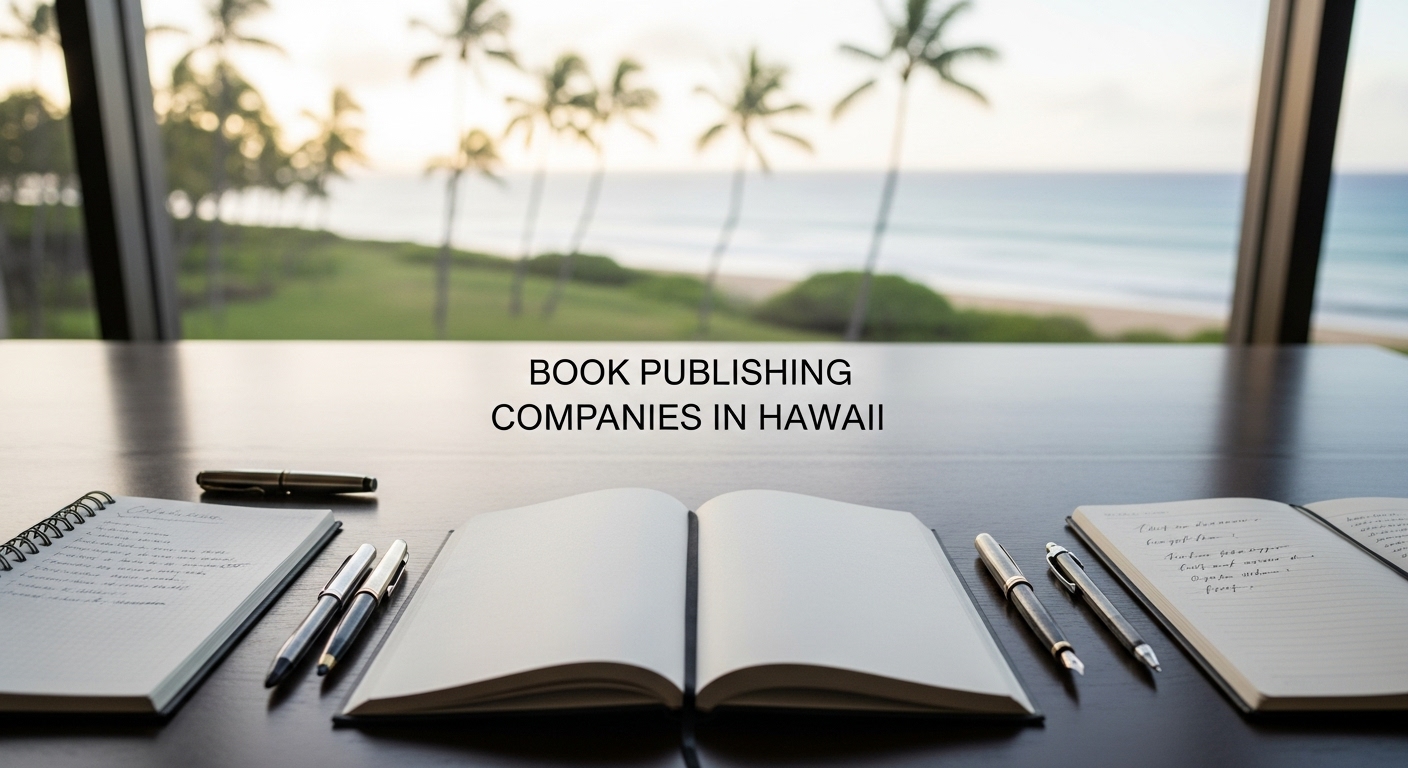
Hawaii’s publishing scene blends island traditions, Pacific-region scholarship, and independent literary energy. From university presses and long-running island imprints to boutique ghostwriters and independent presses that specialize in local histories, memoirs, and children’s books, the Aloha State supports a diverse ecosystem for authors and readers alike. This list presents 55 publishers with relevance to Hawaii in 2025 — including national services that operate locally, university and community presses, and small independent houses.
1. Barnett Ghostwriting
Barnett Ghostwriting is a full-service ghostwriting and book production firm frequently chosen by authors seeking confidentiality, professional editing, and project management from concept to finished manuscript.
- Services: Ghostwriting, editing, book coaching, manuscript development and publishing support.
- Best for: Business books, memoirs, and long-form nonfiction needing a professional, collaborative writer.
2. University of Hawaiʻi Press
The University of Hawaiʻi Press publishes academic, cultural, and Pacific-focused works with a long history of supporting scholarship on Hawaii and the broader Pacific region.
- Focus: Academic titles, regional history, Hawaiian studies, and Pacific anthropology.
- Best for: Scholarly monographs and textbooks with rigorous peer review.
3. Bamboo Ridge Press
A literary press rooted in Hawaii’s creative community, Bamboo Ridge champions local voices through fiction, poetry, and short-form prose.
- Focus: Contemporary literature, local authors, and community anthologies.
- Best for: Literary fiction and short story collections with Hawaiian themes.
4. Mutual Publishing
An island independent press with a reputation for trade books, historical collections, and illustrated works about Hawaiian culture and places.
- Focus: Local history, biography, and illustrated non-fiction.
- Best for: Authors with regional interest projects and richly illustrated formats.
5. Koa Books
Koa Books focuses on titles that celebrate Hawaiian culture, environmental stewardship, and regional storytelling—often balancing trade and specialty markets.
- Focus: Cultural nonfiction, nature writing, and local interest trade books.
- Best for: Authors whose work centers on Hawaiian land, lineage, and community.
6. Island Heritage Publishing
Island Heritage Publishing produces a mix of trade titles and regional works that capture island life, history, and travel.
- Focus: Local history, travel guides, and pictorial coffee-table books.
- Best for: Projects that benefit from strong design and visual presentation.
7. Hawaiian Legacy Press
Specializing in memoir, family histories, and cultural documentation, Hawaiian Legacy Press helps preserve oral histories and community narratives.
- Focus: Memoirs, family histories, and community archives.
- Best for: Authors documenting generational stories or genealogies.
8. Aloha House Publications
Aloha House publishes short-form works and practical guides with an emphasis on Hawaiian lifestyle, food, and outdoor activities.
- Focus: Cookbooks, how-to guides, and lifestyle titles.
- Best for: Practical guides and recipe collections with local flavor.
9. Pacific Heritage Press
Pacific Heritage Press positions itself at the intersection of regional scholarship and accessible trade publishing, often working with local historians and educators.
- Focus: Educational titles, regional studies, and trade nonfiction.
- Best for: Authors seeking an imprint attentive to Pacific cultural contexts.
10. Lehua Press
Lehua Press is a boutique independent press that prioritizes careful editing and design for literary and creative nonfiction works.
- Focus: Literary nonfiction, essays, and artist books.
- Best for: Writers focused on craft-driven narrative nonfiction.
11. Palapala Press
Palapala Press focuses on small runs and print-on-demand options, making it attractive for self-funded authors and niche community projects.
- Focus: Small press titles, limited editions, and POD.
- Best for: Authors looking for flexible production and short print runs.
12. Hana Hou Press
Hana Hou Press publishes travel and regional narrative collections that highlight lesser-known island stories and places.
- Focus: Travelogues, regional essays, and companion guides.
- Best for: Writers documenting island travel and cultural encounters.
13. Pueo Publishing
Pueo Publishing takes a community-centered approach, offering editorial and production support suited to local authors and organizations.
- Focus: Community histories, local-interest trade books.
- Best for: Civic projects and commemorative publications.
14. Kona Coast Press
Kona Coast Press specializes in books about the Big Island—its history, environment, and people—often combining research with vivid photography.
- Focus: Regional history, environmental books, photo-rich titles.
- Best for: Projects that rely on strong visual storytelling.
15. Ohana Books
Ohana Books’ catalogue emphasizes family narratives, local culture, and children’s titles that reflect Hawaiian identity and values.
- Focus: Children’s literature, family stories, and cultural education.
- Best for: Picture books and early readers with local themes.
16. Waikiki Publishing
Waikiki Publishing blends trade publishing with hospitality-market titles (hotel guestbooks, visitor guides) and lifestyle books.
- Focus: Visitor guides, lifestyle, and service-industry-friendly publications.
- Best for: Authors writing travel-friendly or tourism-adjacent books.
17. Lanikai Press
Lanikai Press is a small literary house supporting poetry, essays, and short fiction from local and Pacific Rim writers.
- Focus: Poetry, short fiction, and art-infused books.
- Best for: Poets and short-form fiction authors seeking literary-minded editors.
18. Molokai Press
A community-based imprint, Molokai Press tends toward island memoirs, agricultural histories, and cultural preservation efforts.
- Focus: Oral histories, memoirs, and community documentation.
- Best for: Grassroots projects aiming to preserve local knowledge.
19. Maui Sun Press
Maui Sun Press publishes an eclectic mix of lifestyle guides, culinary titles, and island photography books that celebrate Maui.
- Focus: Cookbooks, lifestyle, and island photography.
- Best for: Visual and culinary projects anchored in Maui.
20. Lanai Literary
Lanai Literary is a small but ambitious press prioritizing regional literary voices and experimental formats.
- Focus: Literary fiction and creative non-fiction.
- Best for: Emerging authors and innovative projects with a Pacific bent.
21. Big Island Books
Big Island Books produces general interest trade titles as well as community-focused histories and local authors’ projects.
- Focus: General trade, local interest, and biographies.
- Best for: Authors writing about Big Island communities and personalities.
22. Naupaka Press
Naupaka Press is an independent imprint focusing on family-friendly nonfiction and educational books about Hawaiian flora, fauna, and culture.
- Focus: Nature guides, children’s educational books.
- Best for: Projects combining education and regional natural history.
23. Kukui Publishing
Kukui Publishing supports illustrated non-fiction, art books, and craft-focused titles that highlight island artisans.
- Focus: Art and craft books, artist monographs.
- Best for: Artists and craftspersons wanting high-quality visual reproductions.
24. Hula House Press
Hula House Press centers on Hawaiian performing arts, including dance, music, and oral traditions, offering both practical and historical works.
- Focus: Performing arts, oral history, and cultural guides.
- Best for: Practitioners and researchers of hula, chant, and music traditions.
25. Pele Publishing
Named evocatively for the islands, Pele Publishing releases a mix of fiction and nonfiction rooted in Hawaiian myths, landscape, and contemporary life.
- Focus: Folklore-inspired fiction and creative nonfiction.
- Best for: Authors blending myth, place, and modern storytelling.
26. Kealohilani Press
Kealohilani Press produces culturally sensitive works with attention to Hawaiian language, protocols, and scholarship.
- Focus: Language resources, cultural protocols, and community scholarship.
- Best for: Projects requiring cultural consultation and respectful representation.
27. Pono Press
Pono Press emphasizes sustainability and environmental stewardship in island contexts, publishing guides and narrative nonfiction on ecology.
- Focus: Environmental nonfiction and sustainable living.
- Best for: Writers working at the intersection of ecology and community.
28. Kaimana Press
Kaimana Press is a boutique trade press focused on memoir, travel, and lifestyle books with a relaxed, island-focused aesthetic.
- Focus: Memoir, travel narratives, and lifestyle.
- Best for: Personal essays and travel memoirs that capture local perspectives.
29. Ke Ola Books
Ke Ola Books supports community wellness, local health traditions, and practitioner-authored titles about healing approaches rooted in place.
- Focus: Health, wellness, and traditional healing practices.
- Best for: Practitioners sharing local approaches to wellbeing.
30. Nohea Publishing
Nohea Publishing produces elegant small-press literary titles—short runs that prioritize design and close editorial collaboration.
- Focus: Literary titles and limited editions.
- Best for: Authors seeking artisan-level production values.
31. Oahu Originals
Oahu Originals publishes neighborhood histories, urban guides, and local-interest trade books that speak to city and suburban life on Oʻahu.
- Focus: Urban history, guides, and local-interest titles.
- Best for: Community historians and local culture writers.
32. Makai Press
Makai Press focuses on marine-related books, coastal ecology, and oceanic photography celebrating Hawaii’s maritime environment.
- Focus: Oceanography, coastal guides, and photography.
- Best for: Authors working on marine science or ocean-focused narratives.
33. Manoa Press
Manoa Press supports literary nonfiction and cultural writing, often drawing from university-connected literary networks and workshops.
- Focus: Essays, cultural studies, and literary nonfiction.
- Best for: Writers bridging scholarly and public audiences.
34. Keiki Books
Keiki Books is a children’s imprint that publishes picture books and early readers with Hawaiian language elements and local storytelling.
- Focus: Picture books, bilingual readers, and early education.
- Best for: Children’s authors and educators focused on Hawaiian culture.
35. ʻĀina Publishing
ʻĀina Publishing prioritizes place-based storytelling and books that explore land, agriculture, and foodways on the islands.
- Focus: Foodways, agriculture, and land-based narratives.
- Best for: Writers documenting food sovereignty and local agriculture.
36. Pacific Rim Press
Pacific Rim Press publishes trade nonfiction and narrative nonfiction that connect Hawaii with broader Pacific-region contexts.
- Focus: Pacific studies, travel narratives, and regional history.
- Best for: Authors situating Hawaii in Pacific dialogues.
37. Seabreeze Press
Seabreeze Press handles lifestyle and leisure titles aimed at local and visitor audiences, from gardening guides to outdoor adventure books.
- Focus: Leisure, outdoor living, and lifestyle.
- Best for: Practical outdoor and garden guides grounded in island conditions.
38. Coral Reef Books
Coral Reef Books specializes in marine conservation titles, dives guides, and richly illustrated natural history books.
- Focus: Marine conservation, dive guides, and photography.
- Best for: Divers, marine scientists, and conservation communicators.
39. Kumulipo Press
Kumulipo Press publishes mythic and poetic works that draw on Hawaiian cosmology and storytelling traditions in contemporary forms.
- Focus: Poetry, mythic retellings, and literary projects.
- Best for: Poets and writers exploring mythology and origin stories.
40. Na Pua Press
Na Pua Press focuses on women’s voices, family narratives, and community health projects with a local orientation.
- Focus: Women’s writing, memoir, and community health titles.
- Best for: Authors telling intergenerational or community-focused stories.
41. Halau Publishing
Halau Publishing works closely with cultural practitioners and educators to develop classroom resources and community curricula.
- Focus: Educational resources and curricula grounded in Hawaiian knowledge.
- Best for: Teachers and cultural educators building resource materials.
42. Leolani Books
Leolani Books is a boutique trade publisher of fiction and creative nonfiction that emphasizes quality editorial development.
- Focus: Trade fiction, literary nonfiction.
- Best for: Emerging novelists and creative nonfiction authors seeking close editorial support.
43. Palapala ʻĀina
Palapala ʻĀina specializes in books about land stewardship, place-based histories, and environmental law as it pertains to Hawaiian places.
- Focus: Land history, stewardship, and policy-adjacent works.
- Best for: Authors writing on land, law, and stewardship debates.
44. Aloha Spirit Press
Aloha Spirit Press emphasizes uplifting narrative nonfiction and lifestyle titles that reflect contemporary island life and values.
- Focus: Uplifting memoirs, lifestyle, and self-help-adjacent titles.
- Best for: Readers looking for positive, place-rooted storytelling.
45. Tradewind Press
Tradewind Press publishes accessible trade nonfiction with a focus on travel, photography, and outdoor experience.
- Focus: Travel writing, photo essays, and outdoor guides.
- Best for: Authors creating visually rich travel and outdoor books.
46. Pacific Islander Press
Pacific Islander Press has a broader Pacific remit but publishes many works by Hawaiian authors, supporting cross-island exchange of ideas.
- Focus: Pacific literature, scholarship, and community projects.
- Best for: Authors seeking connection across island communities.
47. Kapiʻolani Publishing
Kapiʻolani Publishing centers on community-centered histories, school projects, and local cultural documentation.
- Focus: School-commissioned works, local history, and youth projects.
- Best for: Educational institutions and community organizations.
48. Maile Press
Maile Press publishes short-run literary titles and experimental forms, often collaborating with local artists and designers.
- Focus: Experimental literary forms and artist books.
- Best for: Interdisciplinary projects combining text and visual art.
49. Hoʻōla Books
Hoʻōla Books focuses on healing narratives, community health, and books by local healers and practitioners.
- Focus: Healing, traditional medicine, and practitioner-authored guides.
- Best for: Authors documenting traditional and contemporary healing practices.
50. Hoʻokipa Press
Hoʻokipa Press publishes hospitality- and tourism-related books aimed at industry professionals and visitor education.
- Focus: Industry guides, visitor education, and hospitality titles.
- Best for: Authors addressing tourism management and visitor engagement.
51. Liliʻuokalani Press
Liliʻuokalani Press produces commemorative volumes, cultural anthologies, and works intended for community archives.
- Focus: Anthologies, commemoratives, and archival publications.
- Best for: Organizations producing lasting records and commemorative books.
52. Kuleana Press
Kuleana Press emphasizes responsibility in storytelling—editing projects that deal with cultural protocols, consent, and stewardship.
- Focus: Ethically produced cultural materials and protocol-centered works.
- Best for: Authors who require sensitive cultural review and community partnerships.
53. Traditions & Tides Publishing
Traditions & Tides publishes oral histories and place-based narrative collections that capture island elders’ stories and traditions.
- Focus: Oral histories and community narratives.
- Best for: Projects preserving elder voices and community memory.
54. Mālama Books
Mālama Books is mission-driven toward environmental stewardship, producing field guides and community handbooks related to mālama (care).
- Focus: Conservation guides, field handbooks, and stewardship resources.
- Best for: Community groups and conservation-minded authors.
55. Aloha Moon Press
Aloha Moon Press rounds out this list as a small independent publisher focused on experimental nonfiction, poetry, and hybrid forms with a local sensibility.
- Focus: Experimental literature and hybrid genres.
- Best for: Writers pushing genre boundaries and blending forms.
Tips for authors targeting Hawaii publishers
- Know the audience and place. Many Hawaiian presses prioritize work that demonstrates cultural knowledge, respect for local protocols, or clear relevance to island life and Pacific contexts. Projects that engage with community needs or feature place-based storytelling often resonate better than generic, location-agnostic manuscripts.
- Include cultural consultation. If your work touches on Hawaiian language, genealogy, traditional practices, or cultural protocols, seek consultation from cultural practitioners or scholars and note that work in your proposal. Publishers value authors who demonstrate ethical engagement.
- Prepare a concise proposal. For trade and academic presses alike, a clear proposal with a market statement, target audience, sample chapter, and a succinct author bio increases your chances. Academic presses will want a more formal prospectus; community presses often appreciate a strong pitch and samples.
- Consider hybrid routes. Many Hawaiian and Pacific-region projects are well-suited to partnerships with local organizations, grants, or community-funded runs. Explore local arts councils, historical societies, and university partnerships for support.
- Design and photography matter. Island books—especially those about environment, culture, or travel—benefit from thoughtful design and strong imagery. If your manuscript relies on visuals, prepare high-resolution images and a plan for layout.
FAQs
Q: How do I choose between a university press and an independent publisher in Hawaii?
A: University presses suit scholarly, peer-reviewed projects; independent presses are better for trade, local-interest, and design-forward books. Align your manuscript’s purpose with the press’s usual focus.
Q: Are small Hawaiian presses open to first-time authors?
A: Yes — many small presses actively nurture emerging local voices, especially when the work aligns with regional themes or community priorities.
Q: Should I expect large advances?
A: Most small and regional presses offer modest or no advances; instead they provide editorial support, distribution pathways, or mission-driven publishing partnerships. Commercial returns vary widely.
Conclusion
Hawaii’s publishing landscape in 2025 is rich and varied: from scholarly presses that support Pacific studies to independent imprints that elevate island storytellers and boutique services like Barnett Ghostwriting that shepherd individual authors through the publishing process. Whether you’re an academic documenting a local tradition, a memoirist capturing family history, or a children’s author with bilingual readers in mind, there are publishers in or connected to Hawaii that can match your project’s scope and values. Use the mini-profiles above to shortlist presses that align with your manuscript, and remember that respectful cultural engagement, a clear proposal, and an understanding of local audiences will strengthen your submission wherever you choose to send it.





